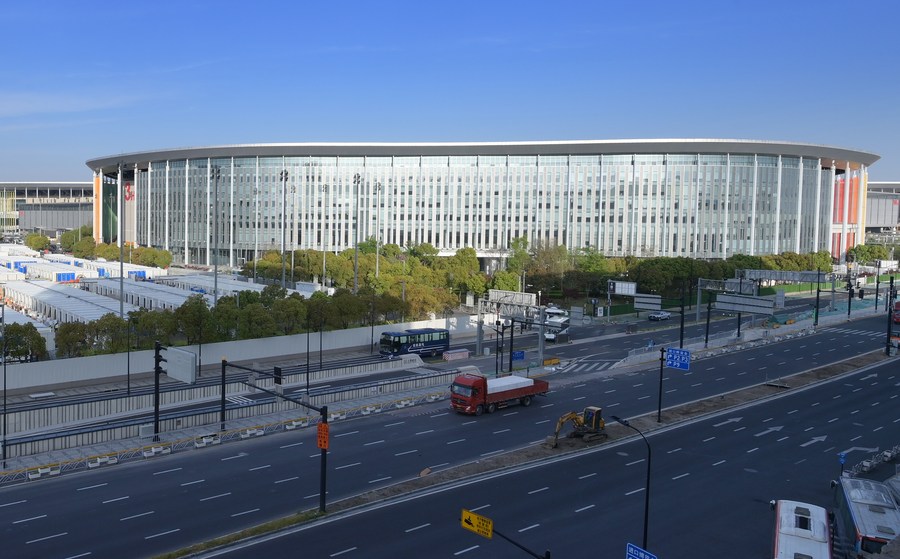Shanghai going all out to ensure productivity amid epidemic

Photo taken on April 9, 2022 shows the exterior view of a makeshift hospital converted from the National Exhibition and Convention Center (Shanghai) in east China's Shanghai. (Xinhua/Li He)
SHANGHAI, April 11 (Xinhua) -- How does Shanghai, a global financial center and the world's largest trading port city with a complete industrial chain of integrated circuits and automobiles, stabilize its productivity when faced with a fierce resurgence of COVID-19?
The first thing that Shanghai, the city with the largest concentration of financial factor markets globally, has to cope with is to ensure that its finance infrastructure runs smoothly and transactions are secure.
Last Friday, the benchmark Shanghai Composite Index closed at 3,251.85 points, up 1.23 percent over the previous eight trading days since the city imposed temporary closed-off management in late March.
The Shanghai Stock Exchange has initiated a plan for the minimum operating unit (team) to work in the office, with other staff working from home since mid-March. On March 27, some technical staff was recalled to the office. To date, 328 minimum operation units (team) were still strictly closed in the data center and office building to ensure the safety of trading operations and technical systems.
In the meantime, the Shanghai International Energy Exchange was serving investors from more than 20 countries and regions on six continents. During the trading week from April 4 to 8, the exchange saw about 1.1 million deals with a more than 480.5 billion yuan (about 75.5 billion U.S. dollars) turnover. It was up about 2 percent and 60 percent, respectively, from last year.
In the past week, 135,000 tonnes of carbon emission quotas were traded on the national carbon market, with a turnover of 7.7 million yuan. It was almost the same as before the epidemic.
"While actively working on epidemic prevention, we have arranged key staff at the office to ensure smooth operation of core businesses and the national carbon trading market," said Lai Xiaoming, general manager with the Shanghai Environment and Energy Exchange.
The National Silicon Industry Group, based in the city's Lingang area, is a major supplier of 300 mm silicon wafers in China. Its Lingang factory has been under closed-off management since March 28, with nearly 400 workers living in tents to ensure the 24-hour smooth operation of the production lines.
"Our shipment of 300 mm silicon wafers reached an all-time high in March, with cumulative shipments exceeding 4.75 million pieces," said Li Wei, president of the group's Zing Semiconductor Corporation.
Just about 10 minutes drive away from the factory, automaker SAIC Motor Company's Lingang base has initiated closed-loop management since March 11. About 4,000 employees live in the factory to ensure the production never stops.
While the city has temporarily entered into a "silent mode" because of the citywide closed-off management due to a new wave of COVID-19, the Yangshan special integrated bonded zone was still filled with the hustle and bustle of the traffic as usual.
The main business of Shanghai Haibo Supply Chain Management Company is to store domestic auto parts in the bonded zone and then declare export according to the demand of overseas orders. Containers were sent to the United States every day.
The big data platform of the customs has enabled enterprises to declare goods online, and the exports can be released automatically, said an employee at Haibo surnamed Fang.
"Currently, Haibo only has eight employees stationed in the company, but its outbound business has not been affected. Since March, Haibo has exported 200 million yuan of various auto parts," Fang said.
In March, 5,916 batches of goods worth 5.43 billion yuan, or 66.1 percent higher year-on-year, were exported from the Yangshan special integrated bonded zone, said Shanghai Customs.
Despite the interrupted land transportation due to some epidemic control measures, Shanghai has maintained round-the-clock operations as an international shipping center and an air freight, postal, and railway services hub.
According to statistics, the Yangtze River Delta railway network sent 254 China-Europe freight trains in March.
Photos
Related Stories
- Driverless vehicles make deliveries in Shanghai amid recent COVID-19 outbreak
- Shanghai launches classified management of city areas to contain COVID-19 spread
- All-out efforts in fighting COVID-19 at newly-built makeshift hospital in Shanghai
- Light show staged at the Bund to support anti-epidemic efforts in Shanghai
- Interview: Scientists, politicians part company in COVID-19 battle, says top British expert
Copyright © 2022 People's Daily Online. All Rights Reserved.










